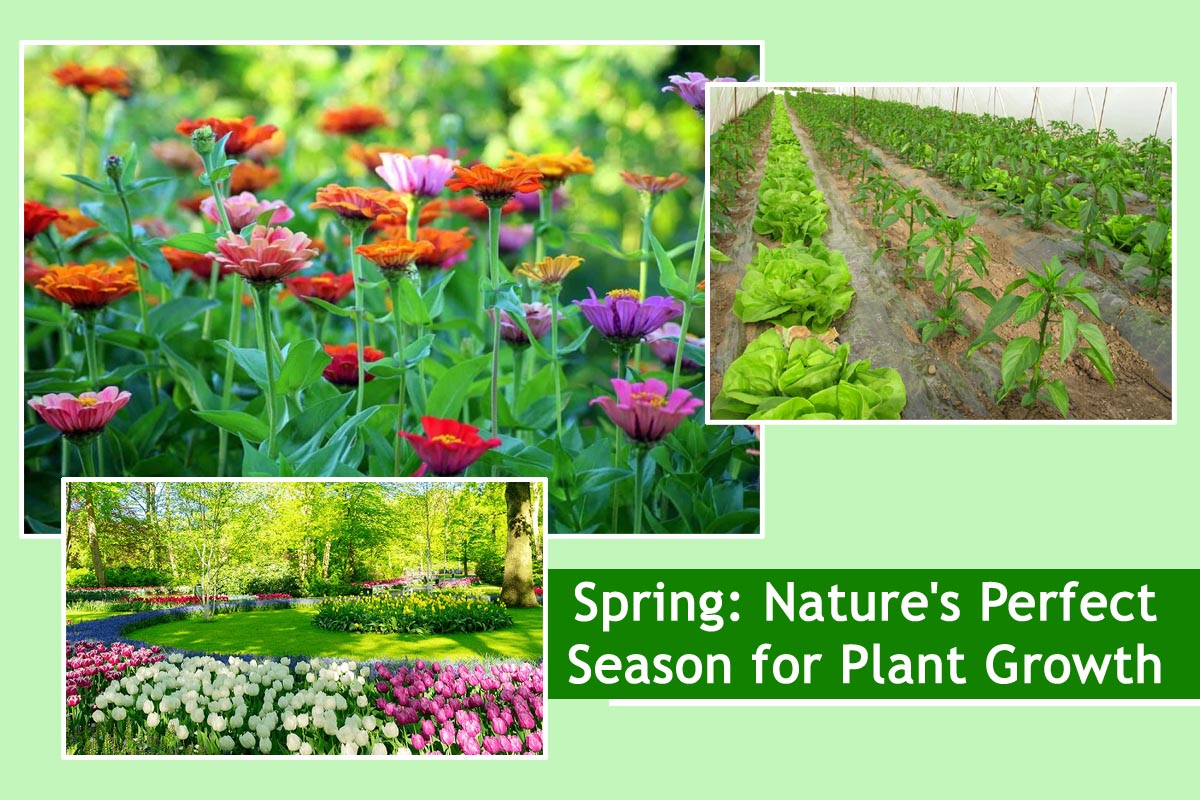
Spring: Nature’s Perfect Season for Plant Growth
To thrive and grow, plants require water, sunlight, warmth, and nourishment from the soil. Plants can quickly adapt to normal temperature fluctuations. During spring, plants encounter the ideal conditions necessary to initiate growth.
With its gentle warmth and vibrant blossoms, spring is undeniably nature’s perfect season for plant growth. As winter’s cold grip loosens, plants awaken to a symphony of favourable conditions stimulating their development and flourishing. Here are five reasons why the spring season is considered the best for plants:
Optimal Temperature :
With its Goldilocks temperature range, spring provides an optimal environment for plant flourishing. Neither too hot nor too cold, this season offers temperatures ranging from 70-80 degrees Fahrenheit (21-26°C) during the day and 60-68 degrees Fahrenheit (15-20°C) at night. This moderate climate is a sweet spot for plants, fostering ideal conditions for essential metabolic processes crucial for robust growth. The temperature balance during spring ensures that plants can efficiently carry out photosynthesis, nutrient absorption, and other vital functions, creating a harmonious environment where nature’s intricate dance of life unfolds with vitality and resilience.
Also Read This : Bottom-Watering: A Friendlier Approach to Potted Plant Care
Abundant Sunlight:
In spring, the extended daylight hours and milder warmth usher in abundant sunlight, a fundamental catalyst for photosynthesis. This prolonged exposure enables plants to harness solar energy efficiently, facilitating the synthesis of sugars essential for growth. The radiant sun nourishes plants at a cellular level and elevates the visual spectacle of blooming flowers and lush greenery. As nature’s spotlight, sunlight plays a pivotal role in shaping the vitality and aesthetic allure of the botanical world during the rejuvenating embrace of spring, turning it into a canvas of vibrant colours and life.
Also Read This : Thriving in Minimal: 7 Indoor Plants That Excel in Low-Nutrient Soil
Balanced Moisture Levels:
Winter’s elevated moisture levels are expected, but cold winds can impede optimal plant growth. Spring, however, marks the restoration of balance as moisture levels stabilize throughout the day and night. This equilibrium proves pivotal in fostering the emergence of new shoots, catalyzing the expansion and development of plants. The stable moisture environment provides a conducive setting for the intricate processes of germination and growth. With this harmonious moisture balance, plants can flourish, creating a rejuvenating and vibrant landscape as nature awakens from its winter slumber.
Also Read This : Homegrown Happiness: Tips and Tricks for Thriving Strawberry Plants
Cool and Pleasant Weather:
The calm and crisp mornings and evenings of spring bring forth a refreshing ambience that is particularly beneficial for plants. The soil’s moisture stability, combined with the gentle breeze, establishes optimal conditions for rapid growth. During this time, leaves exhibit a vibrant sheen, reflecting their vitality, while the overall aesthetic appeal of plants attains its zenith. This cool and pleasant weather contributes to the plants’ physical well-being. It enhances the visual delight of lush greenery, making spring an enchanting season for both nature enthusiasts and the botanical world.
Also Read This : Growing Brinjal (Eggplant) at Home: A Comprehensive Guide for a Bountiful Harvest
Air and Water Harmony:
During spring, refreshing and mild breezes characterize the mornings and evenings, creating an atmosphere of rejuvenation. The air, infused with moisture, holds a harmonious blend of nitrogen and oxygen, fostering an efficient exchange of gases crucial for plant development. This symphony of elements supports photosynthesis and enhances the overall metabolic processes within plants. Furthermore, adequate moisture levels reduce the water demands of plants, ensuring they receive the hydration necessary for healthy and vigorous growth. In this season of renewal, the balanced interplay of air and water harmoniously contributes to the flourishing vitality of the botanical world, creating a landscape of verdant splendour.
Also Read This : Green Serenity: Key Considerations for Thriving Balcony Plants
Why spring season is better for plants
Plants typically thrive during the spring season for various reasons:
- The lengthening daylight hours induces hormonal shifts in plants, stimulating their growth processes.
- The increasing temperatures and abundant moisture establish an optimal environment for germination and overall development. These conditions supply plants with the necessary energy and resources for growth, flowering, and seed production.
- The spring season reduces the risk of frost, which can harm delicate new growth.
In summary, the convergence of extended daylight, warmer temperatures, and heightened moisture levels renders spring a reasonable period for the flourishing growth of most plants.
Also Read This : Planting Oriental Arbor-vitae Made Simple: Easy Tips for Success at Home
In contrast, nitrogen-rich water falls from the sky during the rainy season, relieving the summer heat after spring. This replenishes the greenery once again. In summer, the higher daytime temperatures affect air and soil temperatures, causing plants to wither. After the rainy season, from September to November, tasks such as pruning, re-potting, and grafting can be easily performed, making spring an ideal time for these activities.




